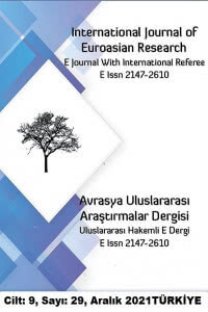İŞSİZLİK ORANI ve İŞGÜCÜNE KATILIM ORANI ARASINDAKİ UZUN DÖNEMLİ İLİŞKİ: TÜRKİYE ÖRNEĞİ
Öz İşsizlik oranı (UR) ile işgücüne katılım oranı (LFPR) arasında uzun dönemli bir denge ilişkisinin olması, işsizlik oranının emek piyasasının ve ekonominin genel durumunu sağlıklı bir biçimde yansıtmasını engelleyebilecektir. Ayrıca böyle bir ilişkinin varlığı, Türkiye de dâhil olmak üzere yüksek işsizlik oranına sahip ülkelerde, işsizlik oranının istenilen seviyelere düşürülmesini engelleyebilecektir. Bu çalışmada UR ile LFPR arasındaki uzun dönemli ilişki Türkiye ekonomisi için Johansen (1988, 1991) koentegrasyon yöntemi ile genel ve cinsiyet düzeyinde seriler kullanılarak incelenmiştir. Çalışmada aylık verilerle 2005:01-2019:04 dönemi kapsanmıştır. Bu çalışmayı literatürdeki diğer çalışmalardan ayıran temel özellikler şunlardır: Öncelikle, koentegrasyon analizinin üzerine kurulu olduğu Vector Autoregression (VAR) modellerinin istatistiksel özelliklerinin uygun olmasına özellikle dikkat edilmiştir. Hem istatistiksel analizin hem de iktisadi yorumların geçerli olması için çok önemli olan bu hususun (Juselius, 2006, s. 46) literatürde genellikle göz ardı edildiği görülmektedir. İkinci olarak, verinin taşıdığı bilgileri bozmamak için farklı frekanstaki verilerin bir araya getirilmesi, interpolasyon ve bazı mekanik mevsimsel düzeltme tekniklerinin tüm serilere uygulanması gibi işlemlerden özellikle uzak durulmuştur. Analiz sonuçları gerek genel gerek cinsiyet düzeyindeki seriler için UR ile LFPR arasında bir koentegrasyon ilişkisi olmadığını göstermiştir. Bu bulgu Türkiye ekonomisi için LFPR’deki değişimler nedeniyle işsizlik oranının ekonominin genel durumunu iyi yansıtmayacağı düşüncesini desteklememektedir. Ayrıca yine bu bulgu, Türkiye ekonomisinde işsizlik oranının düşürülememesinin bir nedeninin LFPR’deki değişimler olduğu görüşünü de desteklememektedir.
Anahtar Kelimeler:
İşsizlik Oranı, İşgücüne Katılım Oranı, VAR Modeli, Türkiye, Zaman Serileri Koentegrasyon
___
- AĞAZADE, S., (2014), “Türkiye’de İşsizlik ve İşgücüne Katılım İlişkisinin Doğrusal ve Doğrusal Olmayan Koentegrasyon Yöntemleri ile Analizi”, Eskişehir Osmangazi Üniversitesi İİBF Dergisi, C. IX, S. 3: s. 145-161.
- ALTUZARRA, A., C. G. GALVEZ ve A. G. FLORES, (2019), “Unemployment and Labour Force Participation in Spain”, Applied Economics Letters, C. XXVI, S. 5: s. 345-350.
- DICKEY, D. A. ve W. A. FULLER, (1979), “Distribution of the Estimators for Autoregressive Time Series with a Unit Root” Journal of the American Statistical Association, C. LXXIV, S. 366: s. 427-431.
- EMERSON, J., (2011), “Unemployment and Labor Force Participation in the United States”, Economics Letters, C. CXI, S. 3: s. 203-206.
- GUSTAVSSON, M. ve P. ÖSTERHOLM, (2006), “The Informational Value of Unemployment Statistics: A Note on the Time Series Properties of Participation Rates”, Economics Letters, C. XCII, S. 3: s. 428-433.
- GUSTAVSSON, M. ve P. ÖSTERHOLM, (2012), “Labor-Force Participation Rates and the Informational Value of Unemployment Rates: Evidence from Disaggregated US Data”, Economics Letters, C. CXVI, S. 3: s. 408-410.
- JOHANSEN, S., (1988), “Statistical Analysis of Cointegration Vectors”, Journal of Economic Dynamics and Control, C. XII, S. 2-3: s. 231-254.
- JOHANSEN, S., (1991), “Estimation and Hypothesis Testing of Cointegration Vectors in Gaussian Vector Autoregressive Models”, Econometrica, C. LIX, S. 6: s. 1551- 1580.
- JOHANSEN, S., (1996), Likelihood-Based Inference in Cointegrated Vector Autoregressive Models, New York: Oxford University Press.
- JUSELIUS, K., (2006), The Cointegrated VAR Model: Methodology and Applications, New York: Oxford University Press.
- KAKİNAKA, M. ve H. MİYAMOTO, (2012), “Unemployment and Labour Force Participation in Japan”, Applied Economics Letters, C. XIX, S. 11: s. 1039-1043.
- KLEYKAMP, D. ve J.-Y. WAN, (2014), “Unemployment and Participation Rates? Revisiting the US Data”, Applied Economics Letters, C. XXI, S. 16: s. 1152-1155.
- KWIATKOWSKI, D., P. C. B. PHILLIPS, P. SCHMIDT ve Y. SHIN, (1992), “Testing the Null Hypothesis of Stationarity against the Alternative of a Unit Root: How Sure are We That Economic Time Series Have a Unit Root?” Journal of Econometrics, C. LIV, S. (1-3): 159-178.
- LEE, J. ve M. C. STRAZICICH, (2003), “Minimum Lagrange Multiplier Unit Root Test with Two Structural Breaks”, The Review of Economics and Statistics, C. LXXXV, S. 4: s. 1082-1089.
- LEE, J. ve M. C. STRAZICICH, (2004), “Minimum LM Unit Root Test with One Structural Break”, Boone NC Appalachian State University Faculty of Economics Working Papers No. 04-17.
- LİU, D.-C., (2014), “The Link Between Unemployment and Labor Force Participation Rates in Japan: A Regional Perspective”, Japan and the World Economy, C. XXX, s. 52-58.
- NGUYEN VAN, P., (2016), “Examining the Unemployment Invariance Hypothesis: The Case of Australia”, The Australian Economic Review, C. XLIX, S. 1: s. 54-58.
- OTOİU, A. ve E. TİTAN, (2016), “Does the Unemployment Invariance Hypothesis Hold for Romania?”, Applied Economics Letters, C. XXIII, S. 12: s. 884-887.
- ÖSTERHOLM, P., (2010), “Unemployment and Labour-Force Participation in Sweden”, Economics Letters, C. CVI, S. 3: s. 205-208.
- PHILLIPS, P. C. B. ve P. PERRON, (1988), “Testing for a Unit Root in Time Series Regression”, Biometrika, C. LXXV, S. 2: 335-346.
- PHILLIPS, P. C. B., (1987), “Time Series Regression with a Unit Root”, Econometrica, C. LV, S. 2: 277-301.
- TANSEL, A. ve Z. A. ÖZDEMİR, (2018), “Unemployment Invariance Hypothesis, Added and Discouraged Worker Effects in Canada”, International Journal of Manpower, C. XXXIX, S. 7: s. 929-936.
- TANSEL, A., Z. A. ÖZDEMİR ve E. AKSOY, (2016), “Unemployment and Labour Force Participation in Turkey”, Applied Economics Letters, C. XXIII, S. 3: s. 184-187.
- YENİLMEZ, F. ve E. KILIÇ, (2018), “Türkiye’de İşgücüne Katılma Oranı-İşsizlik Oranı İlişkisi: Cinsiyet ve Eğitim Düzeyine Dayalı Bir Analiz”, Eskişehir Osmangazi Üniversitesi İİBF Dergisi, C. XIII, S. 2: s. 55-76.
- YILDIRIM, Z., (2014), “The Unemployment Rate and Labor Force Participation Rate Nexus for Female: Evidence from Turkey”, International Journal of Economics and Finance, C. VI, S. 5: s. 139-146.
- ISSN: 2147-2610
- Yayın Aralığı: Yılda 4 Sayı
- Başlangıç: 2012
- Yayıncı: Kürşat Öncül
Sayıdaki Diğer Makaleler
SAFEVİLERDE VEZİR-İ AZAMLIK MÜESSESESİ
AVRUPA'DA DOĞRUDAN YABANCI YATIRIMLAR, TURİZM VE EKONOMİK BÜYÜME ARASINDAKİ DİNAMIK BAĞLANTILAR
MARTIN CRIMP’IN ATTEMPTS ON HER LIFE OYUNUNDA (POST-TRUTH) HAKİKATİN DEĞERSİZLEŞMESİ OKUMA/SI
ANTALYA AĞIZLARINDA DUA ve BEDDUALAR
Mehmet Nuri GÖMLEKSİZ, Ahmet Turan SİNAN, Fatma DÖNER DOĞAN
